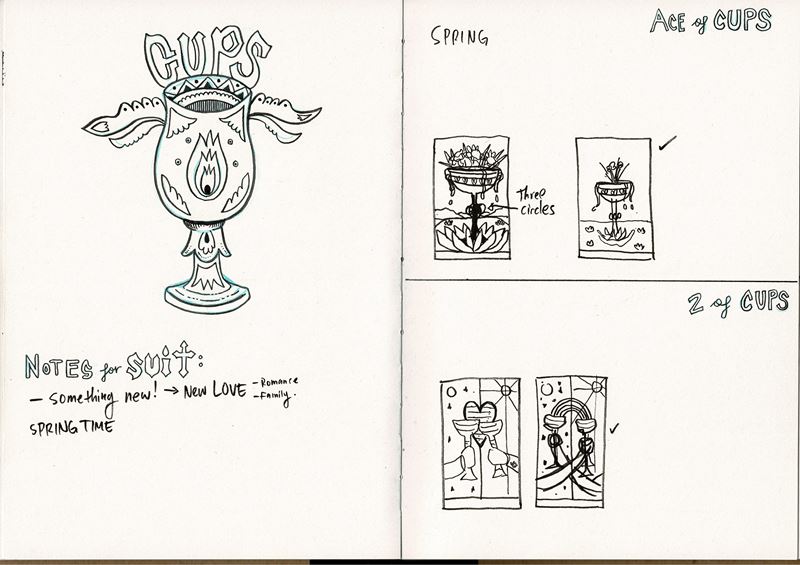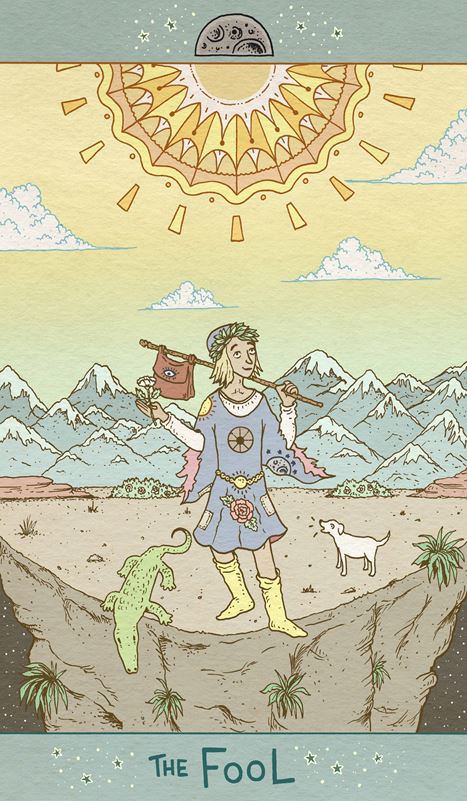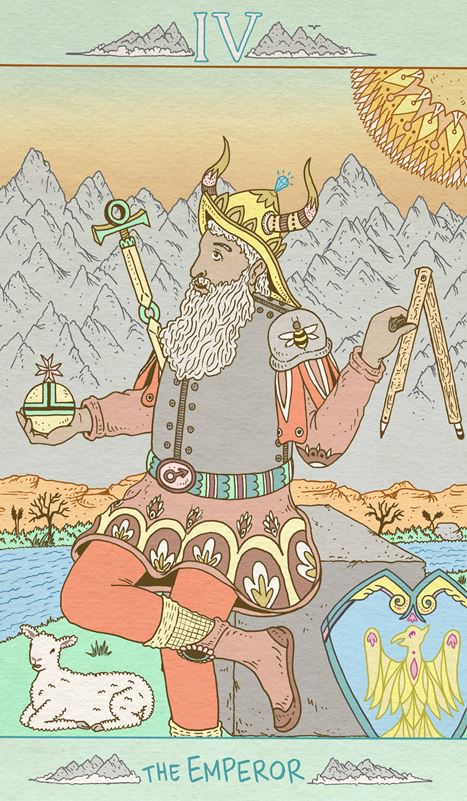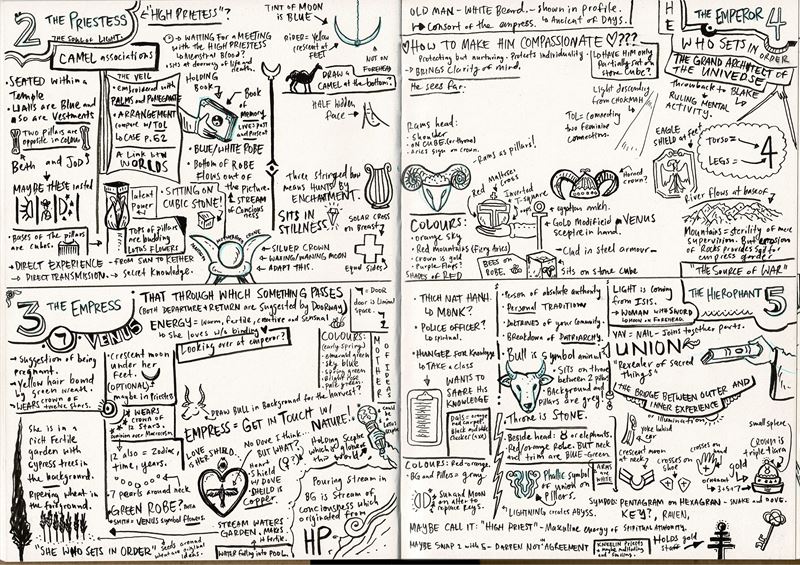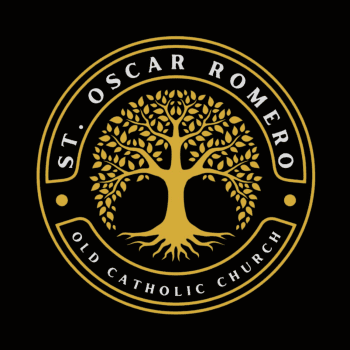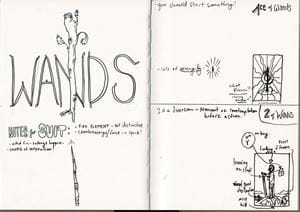
Religion Behind the Scenes spotlights the crucial but less visible tasks that keep religious communities running, and the people who make it all happen.
Tarot cards emerged in 15th century Italy, where they were often used in recreational pastimes. The powerful imagery of the tarot, however, quickly developed a deeper role for countless people, who used the cards in spiritual pursuits. Over the centuries, different tarot decks emerged with new takes on the traditional images, offering even more varied and nuanced interpretations of this spiritual practice.
Darren Shill and Kay Medaglia are the co-creators of the Luna Sol tarot deck, and the founders of Liminal 11, which publishes tarot decks, illustrated books, and comics. In this ‘Religion Behind the Scenes’ they talk about what it takes to create a tarot deck, what misconceptions they encounter about tarot, and the value of the work they do.
--
You decided to create a deck together in 2017, in what became the Luna Sol tarot deck. Walk me through the process. What sort of research did this entail? Who does one talk to when creating a tarot deck?
Darren: In terms of our outside voices, both of us were reading very broadly at the time. I’ve been reading the tarot since I was 16. When I was 17, I traveled a bit around Europe and would read for the backpackers and what have you; so I lost my fear of public reading fairly early, and have been an avid researcher in the world of tarot since. But here, we really took inspiration from the author Michelle Tea, and her book Modern Tarot, which is very anecdotal. She talks about how she experienced something that felt like the ten of cups [which is one of the tarot cards], and then she explains how she explored the ten of cups. We appreciated her style, because we wanted to connect with people in the real world, so that they could look at the card and feel a connection too. Rachel Pollack was another fantastic author. Paul Foster Case is a very old, traditional tarot writer, early 20th century, I believe, but very deep in the symbolism. So, he brought different elements.
Kay: I think his book had the most amount of highlighting in it. He got a lot of detailing because we knew we were trying to bring the old to the new. We weren’t just trying to be modern and throw out the history completely. You have to keep the very oldness, and the old texts were inspiring in that regard.
Darren: The other influence we had was with tarot decks themselves. Say we were looking at the Emperor, for example. There would be somewhere between half a dozen and a dozen emperors in front of us on our table, from different decks, inspiring the conversation as it went. And you could feel the Emperor in the room because he was everywhere.
What do you mean by inspiring the conversation?
Darren: For us, it started with a conversation. On every single card, we would probably spend the whole morning talking, just talking and talking about the cards. And Kay would take notes as we were going along, sort of illustrating. From that it was distilled down into a thumbnail image, to give us a rough structure of the card, which Kay would then go off to fully illustrate and bring to life.
What are the constrictions or rules around this process? What makes a tarot deck a tarot deck?
Darren: What makes a tarot deck a tarot deck? It’s a good question. There's a certain structure that needs to be there, and if that wasn't in place it wouldn't be a tarot deck. There should be 78 cards, of which there should be 22 Major Arcana, or mysteries, so 22 major mysteries, and then followed by 56 minor mysteries. These remaining 56 cards are broken up into four suites, just as you see in normal playing cards. Rather than clubs and spades, however, there are pentacles, which are representative of the element of earth; cups, which represents the element of water; wands, which represents the element of fire; and swords, which represent the element of air.
Then you have court cards, just like you see in a playing card deck as well. There are four cards, however, rather than the three cards of queen, king, and jack that you'd see in a playing card deck. They’re not always called the same thing but, in classical terms, you might often see the first card called a page, and then the knight, and then the queen and the king. In the Luna Sol, we ordered the queen after the king, because it was important to us that she had the ultimate position of power, rather than the king. That reflects the modern world a bit better.
How old is this traditional structure? Do we know?
Kay: As much as we can know, it was developed in Italy in the 15th century. It [is believed by many that tarot] was created in Italy at the same time as playing cards themselves. There's no real certainty as to whether tarot cards came first, or playing cards did, but they're both playing with fortune. When you gamble, you're testing the fates.
So if they follow this basic structure, anybody can create a deck?
Kay: At the core, there's a certain amount of imagery that really should be included on every card. You can go far away from that – and we didn't go far away with the Luna Sol – but, over time, we realized that respecting the symbolism of the tarot is a really big part of making a genuine authentic tarot that resonates the same way the tarot resonates. All of this is to say that in the end, it's a spiritual journey. You can just do whatever you want and call it a tarot technically, though having worked with several different artists, it's fascinating to see which angle you can come at it from.
Darren: It’s following certain archetypes, but it's telling a story with imagery within these archetypes. It's a narrative, through these classical ancient 15th century core images, in a way that is still relatable in the 21st century. That’s what it is.
Can you give me an example? What does it mean to tell different stories with the same core imagery?
Darren: I can talk about a specific card. For example, the Rider-Waite-Smith, sometimes called the Smith-Rider-Waite, was a very iconic and classic deck. And the deck before, called the Marseille, came out a couple of hundred years before that.
In both of those decks, going back hundreds of years, you've got this symbol of a character who's sort of walking along and there's an animal [this is the 'fool' card]. In the very simple Marseilles, the animal is more of a hindrance, like a dog that's running on prowlers, but in the Smith-Rider-Waite, the card has somebody walking off of a cliff and the dog is there behind them, as if in warning. There is a ramshackle feeling, a sense of freedom, a sense of a wanderer in the world, which is exactly what they are, and that sort of sense of innocence.
The idea is that the artist can decide how to interpret the classical imagery? In the sense that a warning can be a harsh, scary card which suggests one should be afraid, or a more gentle card, suggesting the world is trying to warn you off something dangerous?
Darren: Exactly! Number one, you would look for that spirit of the card. You would look for some of these elements.
As a contrast, something like the Emperor, number four in the Major Arcana, is much more solid; it's a much more stable card. Traditionally, it's somebody seated with a scepter, and there's a much more grounded and authoritative air to it. It doesn't necessarily need to be all of the key symbols that you would expect to see there, but there is very much a sort of psychic sense to the card that you can connect to on a certain level. And if that isn't there -- if you have that free-living, love of the fall feeling, in the Emperor -- it wouldn't work, and vice versa.
What does your emperor look like?
Darren: Our emperor is very much part of the natural scenes, so you have the mountains in the background, the stone here, and the shield as well. And the lamb was also an important feature. We brought animals into every one of the cards. Kay and I, we have a strong connection to the natural world. We’re very much animal lovers. So, the shield is almost sort of protecting the lamb here, showing the Emperor’s role in that sense. The card is number four, and that is shown in the leg position, as well, the way his legs sort of form the number four.
We didn't shy away from bringing in as much as we could to each card. For example, you have the compass here in the hand, showing the Emperor's architectural role, his role in building and creating the world around him as much as anything else. So, there's strength, but there's a sense that whilst he is king, he is still serving people. You know, without the realm, the king is nothing, the Emperor is nothing. So, it was important that he was looking back to the Empress, that he was looking back to his family, and to these other reasons for him to create and defend the realm, which are the people, and his extended family as well.
What’s the goal of tarot readings, and how has that evolved over the years?
Darren: In terms of what it does, well, that's been a moveable feast. Historically, we would be talking about fortune tellers, going back to sort of the 18th century; but then it kind of progressed through to divination though, as a high spiritual pursuit, some creators of tarot thought it was tawdry to actually use it to look to the future. But really, it's something you would sit with and reflect on in terms of spiritual growth.
The modern approach is to see it as a tool for self-analysis, self-awareness, self-help, and a psychological tool to help you develop within yourself. You can also use it for fortune telling as well. But people see that it has so many more possibilities, especially in the fluid and turbulent world we exist in currently, right?
Kay: I think it would be worth talking about the little white book, and what it means for people to understand the cards. Before this, we realized that you always throw out the little white booklet, because they're so useless. They're white and really hard to read. Some of them are like a map, and they're hard to fold back down. And when creating Luna Sol, we thought we can do better than this.
This would be the booklet that explained how to read the cards?
Darren: Yes. So, generally, every tarot, nine out of ten times, will come with a little guide to help you. Historically, they've always been called the “little white book” because they are just a tiny little pamphlet stapled together, about a dozen pages. We developed our own little white book, but it's hardback, so that people can carry it around with them and it won't wear out, or lose some pages, or have the staples drop out. It was important to us that people would always have something on hand, but portable, so they can reference back to it.
Would a person reach for a different deck depending on their own emotional state? As in, sometimes we need a bit more of a kick in the pants, and sometimes we need a very gentle message, right?
Darren: Absolutely! At different moments you would, perhaps, look for a different deck. You do tend to find yourself gravitating to one core deck that you feel particularly connected to. And that may not necessarily be the most welcoming deck. For the Lunar Sol, we see this as a very compassionate, healing, open, welcoming deck. When you're looking for support, a sense of growth, or a deck without strong barriers to interaction, then this is there for you.
Kay: I think you go through times, maybe six months a year, that you just come back to the same deck, and it may not be about mood, or the way you feel, or even how you're developing. It's just that you feel a connection to this particular deck at that particular time, and it's hard to put into words why that is. It's more of a spiritual level, perhaps.
What are some misconceptions people might have about tarot?
Darren: There's lots of superstitions around it that aren't necessarily true. For example, some people think that you need to have bought your tarot deck for it to work. It's perfectly possible to go out and buy your own tarot deck, and it will work just as well compared to somebody else buying it for you. I also think it has a reputation for being quite occult. This goes back to its source word, the idea that it represents something sort of hidden and secretive and perhaps supernatural. I think that there's a modern realization that this is just a psychological tool to unlock things within your own self mind, as opposed to necessarily representing outside forces. It's much more for self-reflection than it used to be seen as. I think that that's one of the core misconceptions about working with tarot. But once you do start to work, you realize it's something completely different.
Kay: This might be more on the darker side of tarot, but people think the devil card, or the death card, are the big ones; where, if you pull those, it’s like ‘oh no!’ you’ve pulled death, or you’ve pulled the devil. But actually, it is the tower card, which I don’t think most people know, which is the card of all things crumbling, burning, falling. That’s the big one. If you’re going through a tower moment in your life, that’s worse than a death moment. The death card almost always has a flower in it because it symbolizes rebirth, so it’s a death and a new beginning, and it has a positive spin. And the devil card is really just about hedonism, or having too much fun, and pulling back on that a bit. The tower really is the harshest card, or perhaps the card with the strongest negative energy, where it is hardest to put a positive spin on.
Would a deck be less spiritually powerful, if that makes sense, if it was created without a depth or reverence for the tradition—and just for commercial reasons?
Darren: I don’t think it dilutes the tarot. People are free to express themselves, and it is wonderful that they might wish to express themselves through the tarot. Maybe they don’t have that depth of knowledge, but I don’t think that matters. Personally, I celebrate everyone who would come forward to want to create a deck. I hope not with a sense of commercialism, but I wouldn’t want to judge in that respect.
I think it is very interesting how many people are self-publishing at the moment. In the world of crowdfunding, or Kickstarter, it is fascinating how many people are giving it a go. They’re saying, “I’ve created my own deck, and I don’t need a publisher, and I’m just putting it out there in the world. And if it is supported, and people wish this to live, then it will and, if not, then I won’t have the money to create the deck.” I love the explosion of broad creativity that we can see that with these indie decks.
Kay: Now is the best time ever to self-publish a deck.
How is this work changing for the next generation? What is the future of creating Tarot decks?
Darren: The key points are diversity. People will quite rightly call out a deck now if they don’t see diversity because, if it is trying to represent the world, then it should truly represent the world. And I think people really look out for that a lot today.
What might surprise people about the work?
Darren: The intensity of the work. It took us five months, but this was five months of full-time, dedicated focus. The intensity of the work is immense.
What fueled that commitment? Or what motivates you to do this work?
Darren: We wanted to create things that would be of benefit to the world. That is the source of everything we do, and the tarot cards are no exception. Historically, the Victorian imagery has closed people off, and doesn’t really speak to people. We wanted to create something that would help people; and help them help other people as well.
For our last question, how did you two meet?
Darren: Kay and I have been friends about five years before we started the Luna Sol. We met through a love of comics, which is obviously very different from the world of tarot, but we remained good friends. A few years ago, I saw a comment somebody had left on Kay’s website saying: “You should create a tarot, you'd be wonderful, you'd be the ideal person to create it.” And I saw this, and I thought, well, actually, yes, I 100% agree.
Kay: I had been working on books about positivity back then. I had a series called One Year Wiser, with four books fully illustrated. One was a gratitude journal. One was a once-a-day inspirational book. There was a book on mindfulness, as a long form comic about how to practice mindfulness, and then a coloring book as well, because it was right in the middle of the coloring book craze. So, that's what I was up to.
Darren: So, I contacted Kay straightaway. I sent him an email saying, ‘let's talk about this,’ and Kay very kindly agreed to meet up. We had a few thoughts and ideas as to how we could do this. One was to create the deck between us, because I have a bit of grounding in tarot knowledge and sort of that sense, but Kay is very artistic, and also very spiritual, too. So, he felt that we could create something together collaboratively that would have a lot of depth and use and meaning to people.
Kay: Then we talked about production and distribution. Darren suggested a few ways of doing it early on. One option, he said, was that he would fund me for the time it would take to draw the tarot, and then we'd see what we do with it. And then there was the bigger dream of starting a publisher, which seemed like a pipe dream, but one I thought that was really fascinating.
Darren: Another thought was to go crowdfunding, and then the other thought was to create a deck and sell it to a publisher. But then we sat there, and we just realized we had so many wonderful ideas and so many things that we wanted to bring to life, not just the Luna Sol. The third path, of actually starting a publisher ourselves, from which came Liminal 11, was the path we would take. It was the wildest route we could possibly dream of, the most risky route, that would guide the rest of our lives. But that's the one we chose.
Kay: Something I reflect on with Darren is that it was his first intention to have a tarot deck in the world. That's all he wanted, really. And he got it. The rest of this is just constant gravy on top of a real bucket list, you know? And then a career in publishing is what we both really wanted, and we both got that. But it came out of this desire to create this tarot deck, and I think that set the tone for the rest of the work we do.
Interview conducted, edited, and condensed by Shira Telushkin
--
Shira Telushkin is the managing editor of special projects at Patheos, where she combines her love of stories with her love of all things religion. A graduate of the Harvard Divinity School, she writes, edits, and produces media projects related to faith and beauty in all their forms.
12/1/2022 6:45:35 PM
